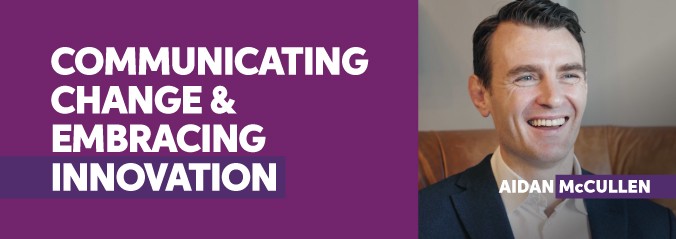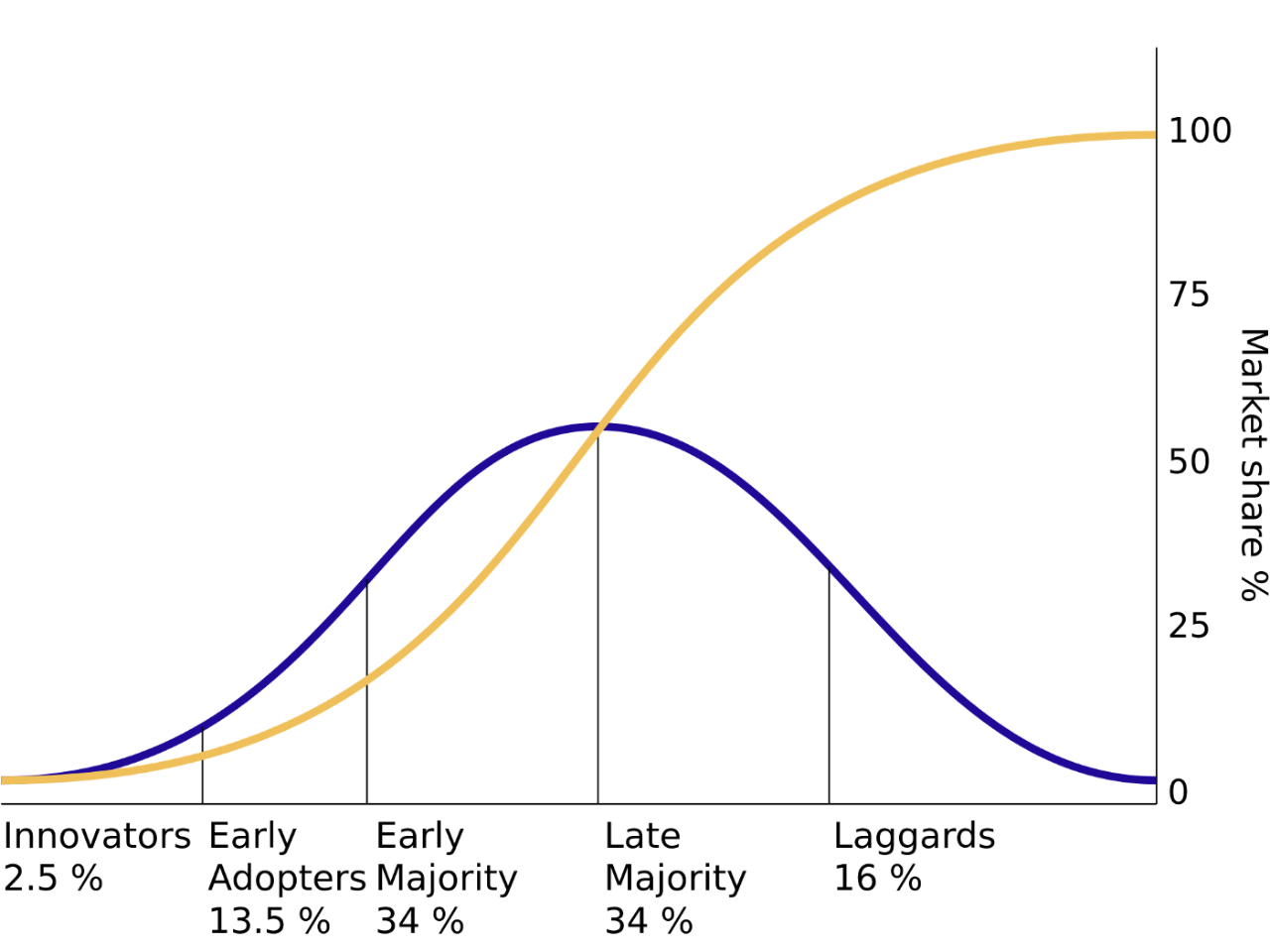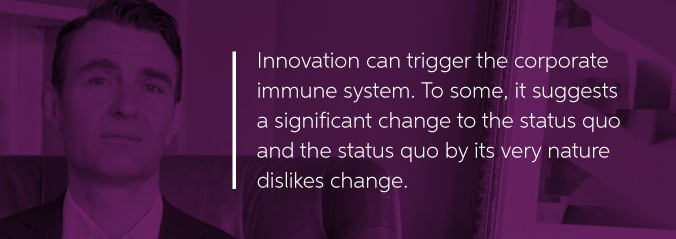Communicating Change and Embracing Innovation

The following guest-blog was written by Aidan McCullen, adjunct professor in Trinity College, host of the Global Innovation Show, corporate workshop and facilitator on disruption and change for organisations.
Need to replace with correct YouTube link
When we get stressed we are not the best version of ourselves and it’s our relationships and our health that bear the brunt of being overloaded.
"Language shapes our behaviour, and each word we use is imbued with multitudes of personal meaning. We must carefully orchestrate our speech if we want to achieve our goals and bring our dreams to fruition.” – Dr. Andrew Newberg, Neuroscientist.
In my corporate workshops, I conduct an experiment to demonstrate how one simple word can hold a multitude of meanings. I ask participants to think of an egg. No trick, no visual prompt, no hint, no priming, just the question. For you now as the reader, please take a moment to see what picture the word ‘egg’ conjures in your mind.
After a few moments, I ask participants to share what image came to mind. The answers include a kaleidoscope of variations: poached eggs, scrambled eggs, fried eggs, chocolate eggs, Fabergé eggs, and even the cosmic egg of the universe.
Answers sometimes include associated images such as an avocado, a nest or a chicken. It is fascinating how one word can spark so many different images. Our answers depend on a melting pot of our previous experiences, cultural heritage, upbringing, age and how those factors interact with our attitudes and beliefs. We see the same effect in the business environment.
Data tells us that 75% of business transformations fail. They fail for the same reasons that 80% of New Year’s resolutions fail. We cannot change what we do until we first change how we think. Within organisations, this translates into: we cannot change business models until we change mental models. So what has this got to do with language?
When articulating change initiatives, many leaders use the word ‘innovation’. Like my (ahem) ‘egg-speriment’ above, the word sparks a multitude of meanings and can be rather vague. It can electrify and excite certain people and exclude and alienate others.
Research shows that innovation often has negative connotations in the business world. In the past, the word signified excessive novelty, without a specific purpose or end. Today, it can still be seen that way. Some of us picture people wearing white coats located in R&D labs, while others imagine designer-bearded hipsters sitting on beanbags in colourful rooms adorned with air hockey and foosball tables.
So why does the word ‘innovation’ not work for everyone?
In Everett Rogers’s 1962 book, The Diffusion of Innovations, the American communications theorist and sociologist introduced a useful way to explain how, why and at what rate new ideas and technologies spread.
Think of a personal experience, perhaps you know someone who always has the latest tech gadget, maybe they read unheard-of books or listen to leftfield music. In Rogers’s diffusion theory below, that person is the innovator and represents a tiny minority of any population.

Diffusion of Innovations
Next comes the early adopters, the early majority, the late majority, and finally the laggards. The laggards are those who are dragged kicking and screaming into the present. In the context of technology, the latter are the people who (choose to) ignore the notifications to update their phone software until they have no choice but to update because their phone does not work anymore. But let’s go back to innovators for a moment.
Innovators are open to new ideas. They are often the first to develop and adopt new ideas. They do not need external validation and often seek forgiveness rather than permission. While it is great to have such trailblazers in an organisation, they are but a very small minority of your people.
If you are an SME, maybe it is one person. If you are a start-up, maybe it is just you the founder. Innovators love to hear leadership talk about change and revel in the use of the word ‘innovation’ but here’s the rub. If only 2.5% of your people are potential innovators (according to the diffusion curve); then we must be cautious with our use of the word ‘innovation’.
Innovation can trigger the corporate immune system. To some, it suggests a significant change to the status quo and the status quo by its very nature dislikes change. Utterance of change sends many of your people into fight or flight mode.

In this state of mind, we tend to double down on what we already know and become resistant to anything new. When our bodies perceive a threat, adrenalin is dumped into our systems. Adrenalin thickens the blood so we bleed slower if we get cut in battle. Blood is diverted from our forebrain – where we do our best thinking – to our fists for fight and our legs for flight.
Our brains restrict non-essential thoughts so we can focus on survival decisions. In addition, stress interferes with the neurological mechanisms that govern language production and perception. Ultimately, when we are stressed, the language circuits in the frontal lobe become less active and we become cognitively closed for business. We are closed to new ideas, we are closed to innovation. If people in your organisation have experienced failed transformation efforts in the past, they will be inclined to resist them even more.
This is problematic because these previous experiences influence our future attitudes and behaviours. Once behaviours are learned, they slip into our unconscious long-term memory where they can be brought into action with barely any conscious effort.
Even when we’ve learned a new behaviour that’s more effective, the earlier memory and behaviour are triggered first. In essence, in order to learn, we need to first unlearn and then relearn. However, if you have experienced failed transformation efforts or you are embarking on your first one, there is good news.
Rather than using the word ‘innovation’, why not try a less ambiguous word like ‘reinvention’, which has had a more positive impact on people in my experience. If we look at Rogers’s diffusion theory, reinvention is more inclusive of the wider population. It not only appeals to your 2.5% innovators, but it also engages the middle majority, that 81.5% as you can see below

Reinvention engages this army of the willing. It honours the past and builds upon it, recognising the hard work of those who got the organisation to where it is today, so they feel empowered to help build the organisation of tomorrow.
Reinvention encourages people who are fearful about the future to work in harmony with those invigorated by it. It means the past and the future are not engaged in a vicious battle, but a fruitful tension. This tension generates great energy necessary to propel your organisation into the future.
The words we use influence the thoughts we have. The thoughts we have influence our behaviours. And, our behaviours become our physical realities.
Remember, our words create our worlds.
Aidan McCullen is the author of Undisruptable: A Mindset of Permanent Reinvention for Individuals, Organisations and Life.
Please be aware that all of the views expressed in this Blog are purely the personal views of the authors and commentators (including those working for AIB as members of the AIB website team or in any other capacity) and are based on their personal experiences and knowledge at the time of writing.
